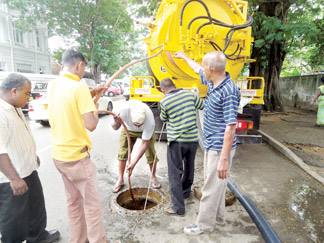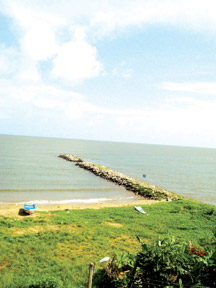|
Greater Colombo Waste Water Management Project:
Efficient sewerage system to enhance Colombo's image
By Ranil Wijayapala
With the ongoing Colombo city beautification programs, improving its
infrastructure to meet the demands of the increasing population and
development needs has become a challenging task.
|

Controller Department of Immigration and Emigration Chulananda
Perera |
It is not only the outward appearance but also having basic hygiene
facilities in keeping with the increasing population and development
requirements has become an essential part of the development drive if it
is to be sustainable.
There is no use in keeping the city beautiful and clean if the
sewerage lines in the city suddenly collapse putting the entire effort
of developing the city in an embarrassing position.
However, Colombo city experienced such situations during the past few
years as roads in the city suddenly collapsed creating huge craters in
busy streets.
The reason for the sudden collapse in city streets was due to the
collapse of sewer lines beneath the roads and the authorities concerned
had to make a big effort to repair the damaged sewer lines,
inconveniencing the public during the rush hour.
Therefore, focusing attention on the nearly 100-year-old sewerage
system in Colombo city has become an important part in the process of
developing Colombo city to be on par with the developed cities in the
world.
The Local Government and Provincial Councils Ministry along with the
Colombo Municipal Council has taken the responsibility of rehabilitating
and repairing the sewerage system of Colombo city under a loan facility
obtained from the Asian Development Bank. According to the Secretary to
the Local Government and Provincial Councils Ministry, R.A.A.K.
Ranawake, the Greater Colombo Waste Water Management Project has been
designed to improve the urban environment and public health for the
urban and suburban residents in Colombo through improvements to waste
water management services.
|

The Colombo North sea outfall |
“The project involves upgrading the sewerage infrastructures,
strengthening institutional and operational capacity and project
management and implementation,” he said.
As mentioned by Richard Eustace Tickell, a British Engineer in his
paper on 'Colombo Drainage Works' in February 1923, in the Minute of
Proceedings Vol.216, of the Institution of Civil Engineers, London, the
planning of the sewerage system in the Colombo Municipal Council area
commenced in 1896 and the construction work had started in 1906. The
major part of the work had been completed by 1925 and it had been funded
by the then government through a loan to the Colombo Municipal Council.
“Therefore, the sewerage system in Colombo city is more than
85-years-old now and during this period it has not undergone major
repairs despite rapid changes and increase in population. The Greater
Colombo Waste Water Management Project has become an urgent need to
fulfil this task,” he said.
The Local Government and Provincial Council Ministry has undertaken a
major part of the Greater Colombo Waste Water Management Project while a
small component of the project in the Dehiwala-Mount Lavinia Municipal
Council has been undertaken by the Ministry of Water Supply and
Drainage.
According to the Project Manager of the Greater Colombo Waste Water
Management Project in Colombo city, Kumudunee Samarasinghe, when the
sewerage system was set up in 1920s they had laid the sewerage lines and
also set up some pumping stations to pump sewage into the sea from two
outfalls in Wellawatte and in Modera.
“These pipe lines are either damaged or corroded as they had not been
repaired from the date they had been laid. The crater on the Galle road
in Wellawatte was due to the collapsing of these sewerage lines during
the rainy seasons due to a problem in the slope of the pipe lines,” she
said.
“The sewerage system gets affected from time to time in many other
areas too during the rainy season. This is because the system is not in
a good condition,” she said. Therefore, this project aims at repairing
and improving the two marine outfalls in Wellawatte and Modera and to
repair a part of the damaged sewer lines and also to repair pumping
stations in many parts of Colombo city. Nearly Rs. 13 billion has been
allocated to improve the sewer lines in Colombo city under this project.
|

The Project area |
The sewerage systems in Dehiwala-Mt. Lavinia Municipal Council and
Kolonnawa Urban Council areas were built between 1983-1987 based on the
Sewerage Master Plan by Howard Humphrey in 1972.
Under the same development plan the sewerage system in Colombo
Municipal Council area was partly rehabilitated and expanded. The sewage
from Dehiwala-Mt. Lavinia Municipal Council and Kolonnawa Urban Council
areas are discharged into the sea through the Colombo sewerage system.
“Therefore, the rehabilitation and repair of the two outfalls at
Wellawatte and Modera are vital under this project,” she said.
This will be a five-year project and the project has been undertaken
by the Provincial Councils and Local Government Ministry. Since the
project comes under the Colombo Municipal Council area the CMC will be
the implementing agency while the Ministry, the executing institute.
Under this project 11 pumping stations will developed and out of that
one will be a new pumping station to facilitate the pumping of sewage
from the Colombo harbour area. Out the ten existing pumping stations,
four will be replaced with new ones as they are dilapidated, Kumudunee
Samarasinghe said.
The balance pumping stations will be repaired either by replacing or
repairing the civil structure or the civil-mechanical structure of these
pumping stations,” she said.
The pumping stations in Bambalapitiya, Wanathamulla, Maligawatta, New
Fort, St. John's Market, Colombo Harbour, Thimbirigasyaya, Borella,
Slave Island, Polwatta and Vystwyke will be rehabilitated and improved
under this project.
Rehabilitation of the sewerage system will be done in many parts of
the Colombo city.
“We selected the sewerage lines that don’t have the capacity to cope
up with the present population in the city. Therefore, 10 kilometers of
sewer lines in a few places in Colombo city will be relaid,” she said.
Accordingly the sewerage lines at Marine Drive, Duplication Road,
Mallikarama Place in Maligawatta, Thurstan road and Flower road will be
relaid.
Apart from that a 125 kilometers of the sewer lines will be checked
by using of CCTV cameras and other sophisticated equipment to find out
the real situation of these sewer lines for future rehabilitation
purposes.
“The project aims at developing the sewerage system in the city to
cope up with the changes in the city in the next 40 years. We have
planned this project according to the city zoning plan prepared by the
Urban Development Authority and they have estimated the population in
different areas in the city. We have planned our project according to
that plan,” she said.
Under the project the capacity of the Colombo Municipal Council to
maintain this sewerage system in a good condition will be improved. In
this regard Greater Colombo Waste-Water Management project will help CMC
build institutional skills, comprehensive technical, financial reforms
and develop suitable operational system and processes, so that the CMC
becomes an efficient and effective waste-water service provider.
Accordingly, the project has purchased four jetting and vacuum
trucks, spare parts and accessories worth over Rs. 164 million for
Colombo Municipal Council. These four jetting machines given to four
Colombo Municipal Council District offices will be used to clean nearly
260 kilometres of sewer lines in the city including 7,000 manholes. The
jetting machines help to clean and unclog sewer lines by removing silt,
hard deposits and encrustations by using a high pressure water jet.
Apart from that there is another component of the project to conduct
awareness programs to educate the public to make them aware of the
coorperation they should extend to the CMC to maintain the sewerage
system in the city,” she said.
She said that a survey is going on to implement the second stage of
the project to cover the areas in the city that have not been covered by
the sewerage system.
“We have identified 11 catchment areas that have not been covered by
the sewerage system in the city. Mattakkuliya and Kirulapona are such
areas. We requested ADB assistance to lay new sewer lines to cover those
areas also but we were told since the sewerage lines already existing in
the city were not in good condition they have to be rehabilitated
first,” she said.
Once this survey is completed Kirulapona and Mattakkuliya will be
provided with a sewerage system under the second phase of the project.
The project is being implemented in accordance with environmental
safeguards, social safeguards, anti-corruption measures, procurement
policy, financial management procedures and information education and
communication strategy that have been agreed upon between Government and
the Asian Development Bank.
“The project commenced in April 2010 and real construction work began
in 2012 and we expected to complete the project by December 2014,” she
said. |


